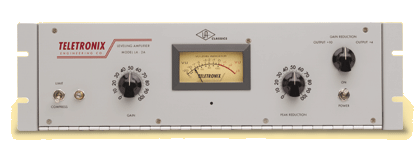
Universal Audio WebZine
Volume 1, Number 3, June 2003
[Employee Feature] [Ask the Doctors] [UAD-1 Artist Feature] [Compression Obsession]
[Support Report] [Dealer Focus] [UAD-1 Tricks] [Interview] [Featured Promotion][Back Issues]
[UA Home]
Compression Obsession: The Amazing Release Character of the LA-2A

The Teletronix LA-2A is probably the most famous compressor in history next to the 1176. Why is it still so popular? Or more specifically, why has its popularity returned with such a vengeance? Let’s find out.
Do you know that fifteen years ago it was common to see guys at studios, radio stations and churches chucking these precious commodities into dumpsters? The complaints were, no controls, takes up too much space, etcetera. Fools! It’s enough to make a gear-geek cry. Now it is common to see used LA-2A’s on the market for $3000 to $4000.
The LA-2A’s number one claim to fame is its incredibly smooth, silky and transparent dynamic control. It is primarily known as a vocal compressor. The LA-2A can rein in the most untamable, dynamically fluctuating performances you can throw its way, and improve the tone to boot. The LA-2A’s second claim to fame is its ease of use. There are two main controls: Peak Reduction, and make-up Gain. It’s a beautiful thing! It’s funny. Once you finally get to use and hear a compressor like the 1176 or the LA-2A, it’s kinda like how when you first learn guitar, and you’re probably using a piece of junk guitar; Then years later you finally pick up a good guitar, and realize, “WOW! I don’t have to try so hard, I just sound good!”, but I digress.
"...fifteen years ago it was common to see guys at studios, radio stations and churches chucking these precious commodities into dumpsters... Fools!"
The only other controls are a Compress/Limit switch and a Meter Select switch. Originally, the Compress/Limit switch was found on the back of the unit. Owners would frequently modify their units, and place the switch on the front. (The UA Classic re-issue has it on the front.) The Compression position is soft knee, “fixed”(not really) at a 4:1 ratio—I’ll explain later. The Limiting position provides an infinity ratio. In practice, you will probably find the differences subtle.
The heart and soul of the LA-2A is a little plug-in canister found on the back of the unit called the T4 cell. This canister plugs in to the LA-2A with the same style connector found on the end of a Leslie speaker cable--very cool.(Just DON’T plug your Hammond into it please!) Inside the sealed canister are an electro-luminescent panel, very much like that found on a “nite-lite”, and two photo resistor cells pressed up against the electro-luminescent panel; one that controls gain reduction, which I will soon explain, and one to control the VU meter when in gain reduction mode.
It is the relationship between the electro-luminescent panel and the photo cells that give us the compression within the LA-2A. The larger the signal that is applied, the brighter the light that is generated, which, in turn, shines upon the photo cell whose resistance is light sensitive. The photo cell responds, and works as the gain reducer, reducing less or more determined by how bright the light gets. This “el-op” design was the first of its kind, and is still reproduced to this day in other compressor products. However, we have our photo cells uniquely manufactured for the LA-2A re-issue to exacting specs that were originally found on the LA-2A. No other manufacturers have access to these cells. What makes the el-op design unique is the fluctuating compression characteristic it imparts. It is 100% program dependent compression with the el-op design. This explains why the LA-2A has such extremely simple controls.
When you have a compressor based on this 100% program dependent design, magical things can happen. Although the compression position on the compress/limit switch on the LA-2A is considered 4:1, really the ratio will fluctuate depending on the source. The LA-2A has a frequency dependent attack, with an average attack time of 10 milliseconds. But the most unique feature of the LA-2A is its program dependent, multi-stage release.
I quote the original Teletronix manual: “[The LA-2A has] a release time which requires about 60 milliseconds for 50% release, and then a gradual release over a period of 1 to 15 seconds to the point of complete release.” You may think of the LA-2A as having a “composite” release; made up of several stages. The duration of this “composite” second stage of release - ruled by the cell's "memory effect" - depends on how long light has been shining on the cell and at what brightness before it ceased. When compression is heavy and/or the signal has been above threshold for a long time, the LA-2A's release will be slower. This allows you to really hit the LA-2A hard with little or no audible amplitude modulation artifacts. Contrary to the original manual, the T4 really seems has a time constant of several minutes, and it may take the meter quite a while to completely return to its stationary position.
More later…
-Will Shanks
Questions or comments on this article?